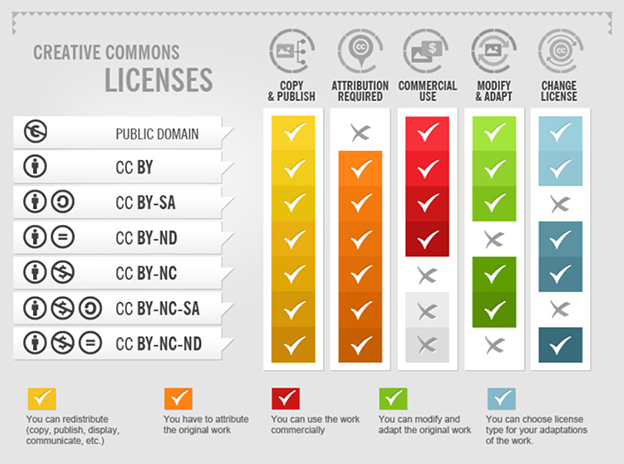Creative Commons and other open licenses
When an author creates a work, Canadian law automatically grants the author(s) full ‘copyright’ over the work. This means, without express permission from the author(s), no one can alter the work in any way or in accordance granted by the Copyright Act (e.g. fair dealing). From the user perspective, if you wish to use a work in a way that doesn’t qualify as a user right, you must get permission from the author(s). The granting of permission is referred to as “licensing”.
Some copyright holders restrict all rights so that permissions are required to use their work. More and more, however, including commercial publishers, proactively offer the work to the public on standard terms so long as terms and conditions are adhered to. Creative Commons licenses are a prominent example of proactive licensing (but not the only one).
Creative Commons is a non-profit organization that provides authors a way to register their work with a standard license that is internationally recognized. These licenses simply outline the permissions and responsibilities of those wanting to use a work without having to contact the copyright owner. These licenses can only be applied by the creator or copyright holder and are irrevocable.
Creative Commons restrictions
There are four different types of restrictions that author(s) can apply; any or all can be included in a license:
- Attribution: the user must give appropriate credit, provide a link to the license and indicate if changes were made. This can be done in a reasonable manner but not such that the credit appears to endorse the user or the manner of use.
- Non Commercial: the material may not be used for commercial purposes (i.e., the user may not use it to make a profit)
- Share Alike: if the user remixes, transforms, or builds upon the material, the product of those contributions must also be distributed under the same license as the original
- No Derivatives: if the user remixes, transforms or builds upon the material, the product of the modifications may not be distributed
Creative Commons licenses
There are six different "flavours" of CC licenses (see image below). All require that the original creator be attributed, but they vary in terms of whether modification, commercial reuse, and re-licensing is allowed.
- Adaptations are modified versions of the original work. Creative Commons or other license with a no-derivatives clause do not allow adaptations to be shared
- Share Alike requires adaptations to be released under the same or an equivalent license
How to Attribute Creative Commons Photos (cropped) (03-04-2015). CC-BY-SA 3.0. https://foter.com/blog/how-to-attribute-creative-commons-photos/
CC-licensed works require an attribution statement when they are reused.
There is no requirement that a work be officially registered, marked with a copyright symbol, etc. in order to be protected by copyright in Canada. Just because something is freely available online does not mean it is not protected by copyright.
Public domain works can be used by anyone for any purpose because the term of copyright has expired. The CC license of this condition is CC0 and often the default license applied in repositories such as data repositories (any specific license that is applied to a work supersedes this condition).
To obtain a CC License
- Choose a License with Creative Commons (recommend Choose beta tool)
- To clarify license choice or the work of concern is a modification of another licensed product, see the Open Publishing service @UML
Other open licenses
Recall that open licenses allow for content to be used, modified and built upon. The type of permissions given to a user of the openly licensed item depends on the creator and the license they have assigned to their work. The benefit of open licenses are they allow the creator to select the permissions and restrictions according to how they would like their content used.
The Open Knowledge Foundation has created a list of Conformant Licenses. This list includes both CC licence versions and alternative content and data licenses (governmental and/or discipline-specific).
Media platforms such as YouTube have specific rights and permissions for use. This information is often found in the ‘More Info’ or ‘Show More’ details menu option of the item.
Resources
- UM Libraries Open Publishing and eScholarship services
- UM Copyright Guidelines
- Flowchart for Determining if a Work is in the Public Domain in Canada
- Fair Dealing Decision Tool
- Creative Commons: A User Guide
- Open Content – A Practical Guide to Using Creative Commons Licenses/The Creative Commons Licensing scheme
- Creating OER and combining licenses (video)

